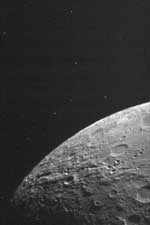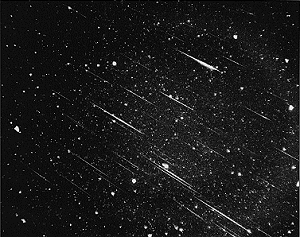| For most stargazers,
this year's quarter Moon during the Leonid meteor shower will be a
blazing nuisance. Bright moonlight will overpower many faint shooting
stars as the Earth passes through the outskirts of three cometary
debris streams during a 36-hour period spanning Nov. 17 and 18, 2000.
by Dr Tony Phillips.
For some astronomers, the Moon itself will be the main event if
a Leonid meteor storm erupts.
"On Nov. 17 [around 0500 UT] the Moon will pass approximately four
Earth-diameters from the center of a dust trail left behind by comet
Tempel-Tuttle in 1932," says David Asher of the Armagh Observatory,
an expert on Leonid debris filaments. "The Moon will be considerably
closer to the trail than Earth," raising the possibility of vigorous
Leonid activity there.
When Leonid meteoroids rain down on the airless Moon, they won't
cause "shooting stars" as they do on our planet. There's no atmosphere
on the Moon where cosmic debris particles can incinerate as fiery
streaks of light. Lunar Leonids will simply hit the ground with
a head-spinning velocity of nearly 140,000 mph.
Prior to 1999, no one had ever recorded natural impacts of any
sort on the Moon. But last year surprised Moon-watchers captured
video footage of at least six exploding Leonid meteorites while
the Moon passed through another debris stream from comet Tempel-Tuttle.
The impact flashes were relatively faint - 3rd magnitude at most
- but they were clearly visible in videos recorded by astronomer
David Dunham and others.
Although the Moon will pass nearly as close to a debris stream
in 2000 as it did in 1999, meteor watchers won't be able to spot
the telltale flashes of lunar Leonids. This year the Moon will plunge
into the stream farside first. All of the meteoroids that hit the
Moon will land on terrain that's hidden from direct view.
Nevertheless, say scientists, there may be a way to monitor this
year's activity indirectly.
"When a Leonid meteoroid hits the Moon it vaporizes some dust and
rock," explains Jody Wilson of the Boston University Imaging Science
Team. "Some of those vapors will contain sodium (a constituent of
Moon rocks) which does a good job scattering sunlight. If any of
the impact vapors drift over the lunar limb, we may be able to see
them by means of resonant scattering. They will glow like a faint
low-pressure sodium street lamp."
Even when there are no ongoing meteor showers, the Moon is surrounded
by a gaseous halo called the lunar "exosphere," says Wilson. Consisting
of a just a few hundred atoms per cubic centimeter, the exosphere
is barely more than a vacuum. The solar wind blows it into a long
tail much like a comet's. It points away from the Sun and extends
for hundreds of thousands of kilometers. The giant tail is so rarefied
that it's completely invisible to the unaided eye even when the
Earth passes through it once a month around the time of the New
Moon.
Wilson and his colleagues at Boston University, led by Prof. Michael
Mendillo, routinely monitor the Moon's tail. They use extraordinarily
sensitive cameras that can detect sunlight scattered from as few
as 5 sodium atoms per cubic centimeter. For comparison, the density
of Earth's atmosphere at sea level is 3 x 1019 molecules/cm3.

NASA
Crators
left on the Moon's surface by the Leonid meteor storms.
|
"The primary goal of our research is to figure out what process
is most responsible for producing the Moon's atmosphere," says Wilson.
"Is it solar radiation, the solar wind, meteoroid impacts, or some
combination? We're still not sure."
"Two years ago the density of the Moon's sodium tail tripled just
after the 1998 Leonid fireball shower," he continued. "The meteoroids
in '98 were larger than usual and they were really slamming the
Moon when they hit. There's no doubt that the primary source of
the exosphere at that time was the Leonids."
Mendillo's group was monitoring the Moon again in 1999 when a full-fledged
Leonid meteor storm burst over Western Europe. "We know that the
Moon was close to a debris trail in '99 because of all the impact
flashes people saw," noted Wilson, "but the sodium concentration
didn't seem to be much greater than normal."
It may be that 1998 was simply special. Leonid particles that hit
the Moon (and the Earth) that year were relatively large ones (like
marbles rather than snowflakes) that had accumulated into a coherent
dust filament as the result of an orbital resonance with Jupiter.
"I suspect the enhanced sodium tail in 1998 was related to the total
mass of the impacting meteoroids rather than to their number," says
Rob McNaught (Australian National University) who studies Leonid
debris trails in collaboration with David Asher. "Of all the recent
years we've studied, 1998 would probably have the greatest mass
hitting the Moon and thus the greatest sodium production."
"I think we'll look back years from now and realize that 1998 was
very special," agrees Wilson. "The fireballs on Earth were unique
and we've never detected another meteor-related enhancement of the
Moon's tail. That includes 1999 when the sheer number of Leonids
hitting the Moon was probably much higher than the year before.
Even in '98, when the sodium density tripled two days after the
shower (that's how long it takes for sodium to travel down the tail
the length of the Moon's orbit), the enhancement didn't last long.
The sodium tail faded back to normal within 24 hours.
"All this could add up to solar processes, not meteoroid impacts,
as the dominant day-to-day producers of lunar exospheric gas. But
we need more data to be sure."

NASA
Dazzled
observers saw brief scenes like this one, captured by A. Scott
Murrell during the 1966 Leonid storm.
|
A better year for spotting lunar Leonids directly is just around
the corner, say meteor experts. On Nov. 18, 2001, the Moon will
be just 2 days past New when a furious Leonid storm is likely to
erupt. David Asher and Rob McNaught predict as many as 10,000 meteors
per hour on Earth and similar numbers of impacts on the Moon. (Leonid
rates in 2000 are likely to be 100 times lower.)
Unlike this year, the 2001 "sub-Leonid point" (the spot where Leonids
crash directly down onto lunar terrain) will be favorably positioned
on the darkened nearside of the Moon, which will appear as a super-thin
crescent. Camcorder shots of detonating Leonids may be possible
for careful photographers filming just after the Sun sets on Nov.
18th next year.
Until then, Leonid impacts will be hidden from direct view. Moon-watchers
must rely on ghostly vapors from the far side of the Moon, and not
their own senses, to tell the tale of the Lunar Leonids 2000.
With this being a busy time for astronomers, we've trawled the
web to bring you some links to help you through. Please take the
time to visit Leonids
Live, Leonids
1833 : The Night of Raining Fire and Leonids
2000.
|
